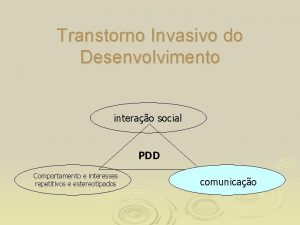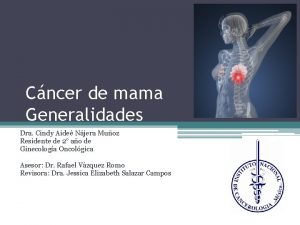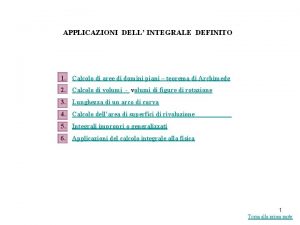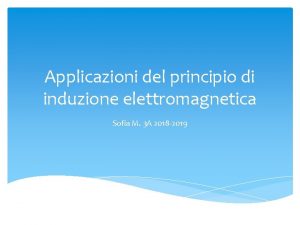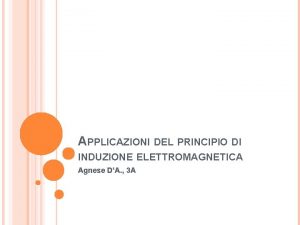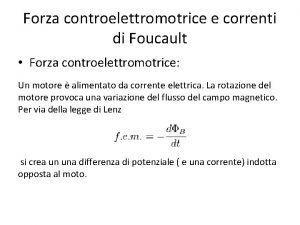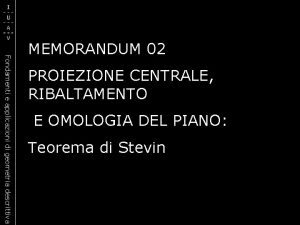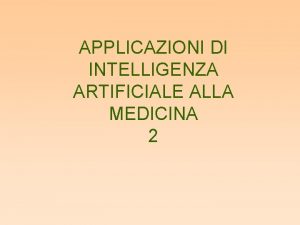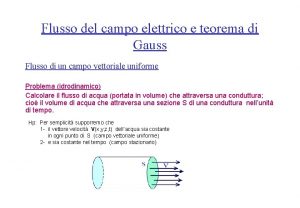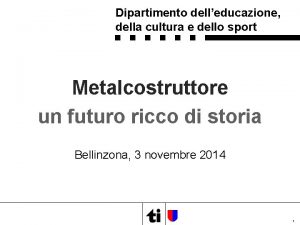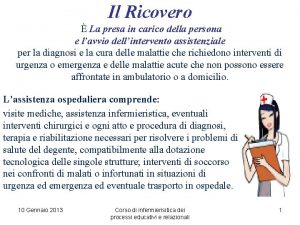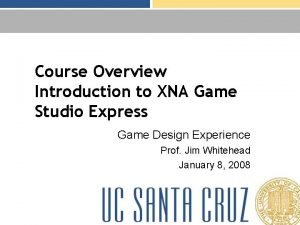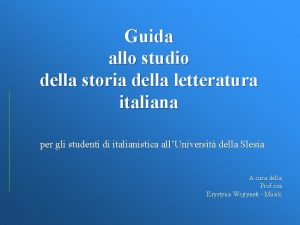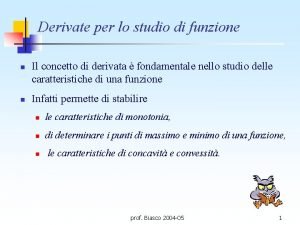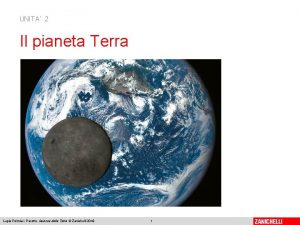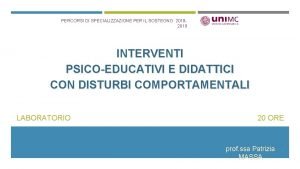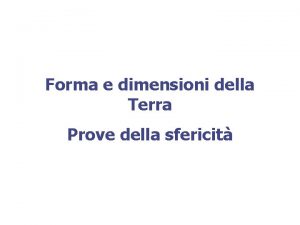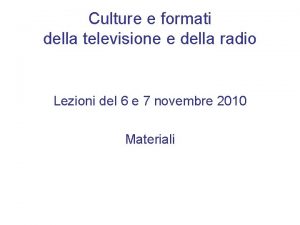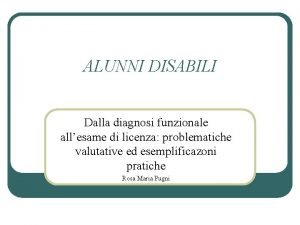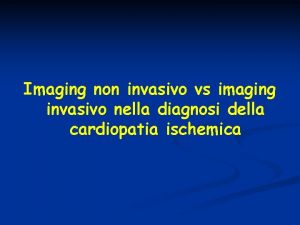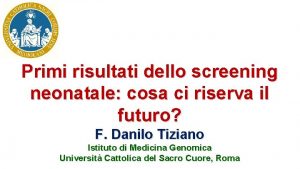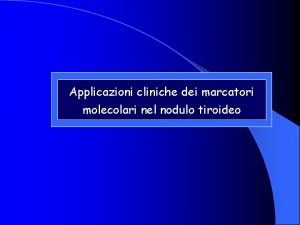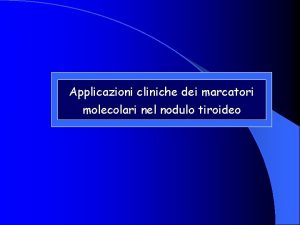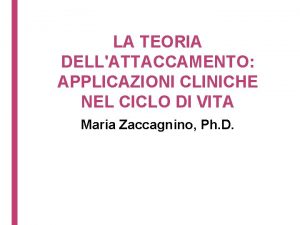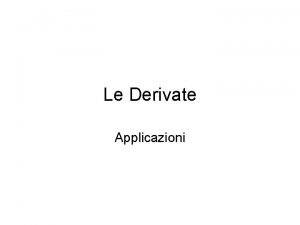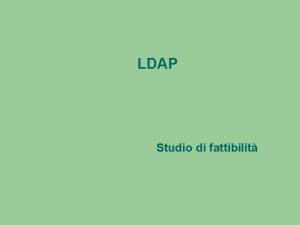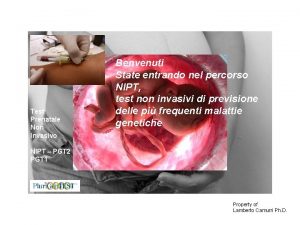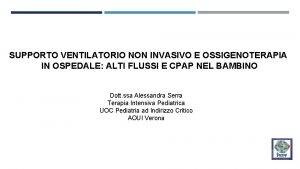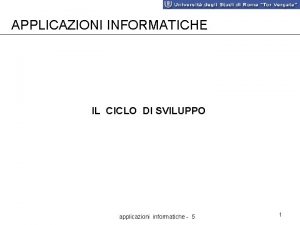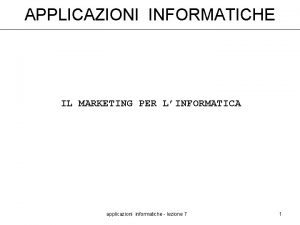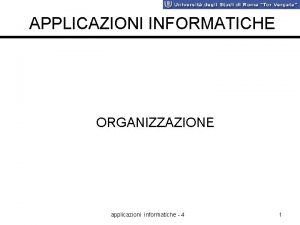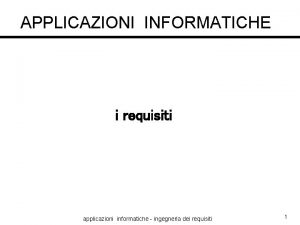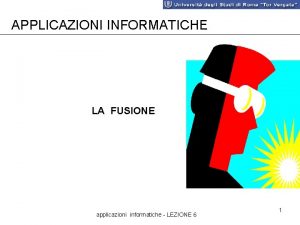APPLICAZIONI CLINICHE DELLO STUDIO NON INVASIVO DELLA RISERVA





































- Slides: 37

APPLICAZIONI CLINICHE DELLO STUDIO NON INVASIVO DELLA RISERVA CORONARICA Ruolo dello studio della riserva coronarica per monitorare il trapianto cardiaco Francesco Tona MD, Ph. D Padova

What is cardiac allograft vasculopathy? CAV results in the narrowing and occlusion of the coronary arteries • Occurs in >40% of heart transplant patients at 5 years after transplantation 1 • May result in graft loss and recipient death Difference between atherosclerotic plaque and CAV 2 • A conventional atherosclerotic plaque has a characteristic lipid core and focal distribution • CAV has characteristic concentric intimal thickening and a diffuse distribution Atherosclerosis – Cellular proliferation appears central to the pathogenesis of CAV 1. Hussain T et al. Circulation 2007; 115: 1798– 805 2. Avery RK. N Engl J Med 2003; 349: 829– 30 Lipid core Intimal thickening

What is cardiac allograft vasculopathy? F Tona et al. Current Vascular Pharmacology (in press)

CAV significantly reduces survival rates in heart transplant patients Transplants: April 1994–June 2006 Survival (%) No CAV (n=13, 244) CAV (n=3104) p<0. 0001 Time after report of CAV (years) Hertz MI et al. J Heart Lung Transplant 2008; 27: 937– 42

CAV is clinically silent Silent myocardial infarction CAV lacks premonitory signs 1 Severe arrhythmia Sudden death Treatment and early diagnosis are vital Treatment Early diagnoses • Optimisation of immunosuppressive therapies • Treatment of co-morbidities • IVUS – Hyperhomocysteinaemia, hyperlipidaemia, hypertension anti-oxidants, anti-CMV, diabetes – Most sensitive method to detect CAV 2 – Shows lumen diameter and thickness of intima and lumen • Coronary angiography – Standard for CAV diagnosis in most transplant centres 2 – May underestimate CAV disease process 1 • Coronary vasomotor alterations – Activation of allograft endothelium <3 months of transplant associated with CAV progression 2 1. Mehra MR. Am J Transplant 2006; 6: 1248– 56 2. Schmauss D, Weis M. Circulation 2008; 117: 2131– 41

Coronary angiography in cardiac allograft vasculopathy Stanford Classification 1988 (according to lesion type) A discrete stenosis, tubular stenosis, multiple stenoses in the proximal, middle, or distal segment branches B 1 proximal vessel maintaining normal diameter with abrupt onset of distal concentric narrowing and obliteration B 2 gradual transition from normal proximal vessel with tapering concentric narrowing gradually increasing in severity distally C diseased vessels, diffusely irregular, that have lost small branches and exibit terminations that are often non tapered, squared off, and end abruptly

ISHLT CAV-0 (Not significant): No detectable angiographic lesion ISHLT CAV-1 (Mild): Angiographic left main (LM) <50%, or primary vessel with maximum lesion of <70%, or any branch stenosis <70% (including diffuse narrowing) without allograft dysfunction ISHLT CAV-2 (Moderate): Angiographic LM ≥ 50%; a single primary vessel ≥ 70%, or isolated branch stenosis ≥ 70% in branches of 2 systems, without allograft dysfunction ISHLT CAV-3 (Severe): Angiographic LM ≥ 50%, or two or more primary vessels ≥ 70% stenosis, or isolated branch stenosis ≥ 70% in all 3 systems; or ISHLT CAV 1 or CAV 2 with allograft dysfunction (defined as LVEF ≤ 45% usually in the presence of regional wall motion abnormalities) or evidence of significant restrictive physiology (which is common but not specific)

IVUS laboratory measurements Lumen Area Minimum intimal thickness Intimal area Cross sectional area (mm 2) Maximum diameter (mm) Minimum diameter (mm) Intimal thickness Intimal area (mm 2) Maximum intimal thickness (mm) Minimum intimal thickness (mm) Media-adventitia Maximum intimal thickness Cross sectional area (mm 2) Media-adventitial area Maximum diameter (mm) Minimum diameter (mm)

Angiography vs Intravascular Ultrasound 3. 1 mm

Endothelial Dysfunction in Cardiac Allograft Vasculopathy: Potential. Pharmacological Interventions Osto E & Tona F et al. Current Vascular Pharmacology 2010 Microvasculopathy

Simultaneous assessment of fractional and coronary flow reserves in cardiac transplant recipients. Physiologic investigation for transplant arteriopathy (PITA study) W Fearon et al. Circulation 2003

Pathology and mechanisms of graft arterial disease RN Mitchell et al. J Clin Invest 2004

Multimodality cardiac imaging in the transplanted heart Endothelial dysfunction Reperfusion injury, rejection, CMV, HTN, dyslipidemia, insulin resistance, immunosuppression medication IVUS MDCT * IVUS Coronary angiography Coronary intimal hyperplasia Epicardial coronary stenosis Cardiac allograft inducible ischemia Cardiac CT * ? Small vessel disease MDCT Echocardiography (TDI, Doppler, SRI) CMR *investigational Myocardial fibrosis and systo-diastolic dysfunction Adapted from JD Estep et al. J Am Coll Cardiol Img 2009; 2: 1126 -1140 DSE CE-ECHO * Stress-MPI

Coronary flow reserve by contrast-enhanced echocardiography: a new noninvasive diagnostic tool for cardiac allograft vasculopathy 2. 7 p<0. 0001 Spec. 87% Sens. 82% ANY CAV F Tona et al. Am J Transplant 2006 Spec. 78% Sens. 96% SIGNIFICANT CAV (>50%)

Coronary flow reserve by contrast-enhanced echocardiography: a new noninvasive diagnostic tool for cardiac allograft vasculopathy F Tona et al. Am J Transplant 2006

Coronary flow reserve by contrast-enhanced echocardiography: a new noninvasive diagnostic tool for cardiac allograft vasculopathy F Tona et al. Am J Transplant 2006

Coronary flow reserve by transthoracic echocardiography predicts epicardial intimal thickening in cardiac allograft vasculopathy y=-1. 35 x + 41. r=0. 796; SEE=0. 23; p<0. 0001 Tona F et al. Am J Transplant 2010

Coronary flow reserve by transthoracic echocardiography predicts epicardial intimal thickening in cardiac allograft vasculopathy Tona F et al. Am J Transplant 2010

Coronary flow velocity pattern and coronary flow reserve by contrastenhanced transthoracic echocardiography predict long-term outcome in heart transplantation Tona, F. et al. Circulation 2006; 114: I-49 -I-55 Copyright © 2006 American Heart Association

Coronary flow velocity pattern and coronary flow reserve by contrastenhanced transthoracic echocardiography predict long-term outcome in heart transplantation Tona, F. et al. Circulation 2006; 114: I-49 -I-55 Copyright © 2006 American Heart Association

Kaplan-Meier estimation for overall survival, ie, the combined end point death or cardiac retransplantation in patients with (MVP+) and without (MVP-) stenotic microvasculopathy Hiemann, N. E. et al. Circulation 2007; 116: 1274 -1282 Copyright © 2007 American Heart Association

Microvasculopathy preceeds and predicts epicardial angiographic cardiac allograft vasculopathy in heart transplant patients Osto E. & Tona F. Circulation (abs AHA Scientific Sessions) 2010

Microvasculopathy preceeds and predicts epicardial angiographic cardiac allograft vasculopathy in heart transplant patients Osto E. & Tona F. Circulation (abs AHA Scientific Sessions) 2010

Multimodality cardiac imaging in the transplanted heart Endothelial dysfunction Reperfusion injury, rejection, CMV, HTN, dyslipidemia, insulin resistance, immunosuppression medication IVUS MDCT * IVUS Coronary angiography Coronary intimal hyperplasia Epicardial coronary stenosis Small vessel ECHO-CFR disease MDCT Cardiac allograft inducible ischemia Echocardiography (TDI, Doppler, SRI) CMR Cardiac CT * *investigational Myocardial fibrosis and systo-diastolic dysfunction Adapted from JD Estep et al. J Am Coll Cardiol Img 2009; 2: 1126 -1140 DSE CE-ECHO * Stress-MPI


Multicenter intravascular ultrasound validation study among heart transplant recipients: outcomes after five years Kobashigawa J et al J Am Coll Cardiol 2005

Everolimus for the Prevention of Allograft Rejection and Vasculopathy in Cardiac Transplant Recipients Eisen HJ et al N Engl J Med 2003

Coronary flow velocity pattern and coronary flow reserve by contrastenhanced transthoracic echocardiography predict long-term outcome in heart transplantation Tona, F. et al. Circulation 2006; 114: I-49 -I-55 Copyright © 2006 American Heart Association

Impaired coronary flow reserve in heart transplant patients with normal coronary angiograms: predictive role of interstitial fibrosis and medial thickening of intramyocardial coronary arteries CFR</=2. 5 CFR>2. 5 WT=[(VA+MA)/π] ½ - (VA/π) ½ Tona F. et al. Eur Heart J 2007

Long-Term Cardiovascular Risk in Transplantation: Insights From The Use of Everolimus in Heart Transplantation Eisen HJ. et al Nephrol Dial Transplant 2006

Everolimus prevents the development of microvasculopathy after heart transplantation Tona F. Eur Heart J (abs ESC Scientific Sessions) 2009

Effect of rapamycin therapy on coronary artery physiology early after cardiac transplantation Sinha SS Am Heart J 2008


Determinants of coronary flow reserve in heart transplantation: a study performed with contrast-enhanced echocardiography Osto E. et al. J Heart Lung Transplant 2009; 28: 453 -460 B ± SE p TRS -0. 101 ± 0. 363 -0. 057 0. 7 RS 1 yr -0. 006 ± 0. 849 -0. 004 0. 9 sev TRS -2. 805 ± 1. 137 -0. 316 0. 01 sev RS 1 yr 2. 811 ± 2. 383 0. 363 0. 2 Total n rejections -0. 004 ± 0. 119 -0. 011 0. 9 ANOVA p 0. 01 R 2 0. 136

Impaired endothelial progenitor cell recruitment may contribute to heart transplant microvasculopathy Osto E & Tona F, J Heart Lung Transplant 2011; 30: 70 -76

SUMMARY • Ruolo della compromissione microcircolatoria nella diagnosi di coronaropatia del graft angiografica • Ruolo della valutazione funzionale microcircolatoria nella stratificazione del rischio di eventi maggiori e della comparsa di CAV angiografica in pazienti a coronarie indenni • Ruolo della funzione microcircolatoria nella diagnosi di coronaropatia diagnosticata all’IVUS • Ruolo nella valutazione immunosoppressori dell’efficacia dei nuovi farmaci • Ruolo nella comprensione dei meccanismi eziopatogenetici della coronaropatia del graft

Escaping Heart Keith Hering
 Applicazioni della proporzionalità
Applicazioni della proporzionalità Transtorno invasivo do desenvolvimento o que é
Transtorno invasivo do desenvolvimento o que é Transtorno invasivo do desenvolvimento
Transtorno invasivo do desenvolvimento Transtorno invasivo do desenvolvimento
Transtorno invasivo do desenvolvimento Arteria axilar
Arteria axilar Applicazioni integrali alla fisica
Applicazioni integrali alla fisica Induzione elettromagnetica applicazioni
Induzione elettromagnetica applicazioni Induzione elettromagnetica applicazioni
Induzione elettromagnetica applicazioni Correnti di foucault applicazioni
Correnti di foucault applicazioni Omologia piana
Omologia piana Applicazioni intelligenza artificiale in medicina
Applicazioni intelligenza artificiale in medicina In prossimità di una distribuzione piana infinita
In prossimità di una distribuzione piana infinita Diodi ideali
Diodi ideali Equazioni differenziali applicazioni economiche
Equazioni differenziali applicazioni economiche Dipartimento dell'educazione della cultura e dello sport
Dipartimento dell'educazione della cultura e dello sport Ala di riserva don tonino bello
Ala di riserva don tonino bello Presa in carico con riserva
Presa in carico con riserva Riserva di legge relativa
Riserva di legge relativa Riserva rivalutazione ace
Riserva rivalutazione ace Xna visual studio 2017
Xna visual studio 2017 Xna game studio visual studio 2017
Xna game studio visual studio 2017 Toc toc quelqu'un frappe à ma porte
Toc toc quelqu'un frappe à ma porte Unione spiritica italiana
Unione spiritica italiana Concavità derivata seconda
Concavità derivata seconda Prove della sfericità della terra
Prove della sfericità della terra Il racconto della chimica e della terra soluzioni
Il racconto della chimica e della terra soluzioni Il racconto della chimica e della terra soluzioni
Il racconto della chimica e della terra soluzioni Il racconto della chimica e della terra esercizi svolti
Il racconto della chimica e della terra esercizi svolti Disturbo misto della condotta e della sfera emozionale
Disturbo misto della condotta e della sfera emozionale La coccinella in cerca della felicità pdf
La coccinella in cerca della felicità pdf Prove della sfericità della terra
Prove della sfericità della terra Terzo principio fichte
Terzo principio fichte Culture e formati della televisione e della radio
Culture e formati della televisione e della radio Sociologia della cultura e della comunicazione units
Sociologia della cultura e della comunicazione units Soluzioni il racconto della chimica e della terra
Soluzioni il racconto della chimica e della terra Pei disturbo misto della condotta e della sfera emozionale
Pei disturbo misto della condotta e della sfera emozionale Caratteristiche della seta
Caratteristiche della seta Simonetta klein il racconto della chimica
Simonetta klein il racconto della chimica

